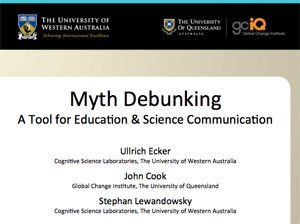
Our recent review paper “Misinformation and its Correction: Continued Influence and Successful Debiasing,” in the December 2012 issue of Psychological Science in the Public Interest summarizes where misinformation comes from, how it affects cognition, and what strategies are available to reduce its impact. We now present an open-access slideshow, designed in Microsoft Powerpoint, summarizing both the basic research on misinformation and recommendations on how to deal with misinformation in practice.
The modern day information society brings with it an unprecedented level of access to information. Information is spread faster and more widely than ever before. The increasing use of social media and the internet to disseminate information means that information is also spread with much less “editorial” fact-checking—the modern media landscape places the onus on the consumer to check the facts and decide what best to believe. Therefore, individuals not only have greater exposure to misinformation, but the need to appropriately deal with misinformation has also risen.
Dealing with misinformation is hence a major challenge for contemporary society. It is an issue for policy-makers, as their efforts can be derailed by misinformation campaigns even when these campaigns come from sources of limited credibility.
It therefore also presents an issue for journalism and the media, which in recent decades has moved away from being a fact-checking entity to presenting “balanced” coverage of issues and opinions, even when there is no corresponding balance in evidence. The area of climate change research can serve as an example, where the (Australian) media keeps portraying a debate on the evidence for anthropogenic climate change despite the overwhelming scientific consensus.
This shows that misinformation effects are also an issue for scientists across domains because science communication needs to be optimized to be able to compete with information dissemination via mainstream and social media, which do not worry (much) about evidence.
Worse yet, sometimes science communication has to compete with strategic misinformation campaigns from vested interests. Hans-Joachim Schellnhuber—a world-leading climate scientist—stated in 2009 that “90% of research [on global change] will have to be done by the social scientists.” In this case, he argues that the work of physicists is largely done, and that it is now up to social scientists to overcome misinformation and assist in the implementation of necessary change in attitudes and behaviour.
The scientific community faces significant challenges in publicizing important research findings and recommendations based on scientific evidence. Surveys show that trust in science is diminishing, so it is becoming increasingly important for scientists to communicate effectively with the public.
A good understanding of misinformation effects is fundamental to tackling these issues. Our research offers theoretically-grounded answers to the questions of why and how misinformation affects people’s memory and reasoning, as well as “hands on” recommendations on how best to minimize the impact of misinformation.
There is already a brief “Debunking Handbook”(Cook & Lewandowsky, 2011) available that offers some recommendations on how best to counter misinformation. It has been downloaded more than 500,000 times and translated into Dutch, French, German, Italian, Spanish and Swedish . Googling "Debunking Handbook" yields over 15,000 results so the short booklet certainly has had a wide influence.
We now introduce a new tool for educators: the “Myth Debunking Slideshow” (Ecker, Cook & Lewandowsky, 2012).
With 55 slides, it provides an intermediate level of detail in summarizing the literature and providing recommendations on how to deal with misinformation. The presentation is designed in popular Microsoft PowerPoint software, and is licensed under Creative Commons, meaning it is free to use, adapt and distribute under most conditions.
The entire presentation or individual slides can be used in classrooms or incorporated into other presentations. We hope it will serve as a guideline and information repository for educators and communicators of science.
Posted by Ullrich Ecker on Monday, 4 February, 2013
 |
The Skeptical Science website by Skeptical Science is licensed under a Creative Commons Attribution 3.0 Unported License. |